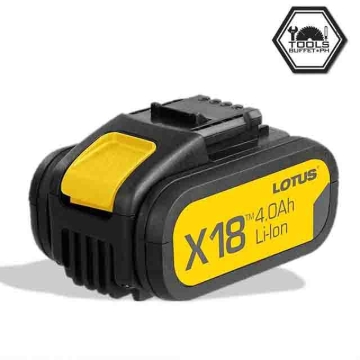Product tags
- battery (11)
Related products
Ridgid 3.7V Li-Ion Battery for MicroExplorer Camera, 30198
30198
Ridgid 3.7V Li-Ion Battery for MicroExplorer Camera
₱28,000.00
9419L Pelican - Replacement Battery
PL9419L
ACCS, NIMH REPLACEMENT BATTERY PACK FOR 9410L
₱5,250.00 ₱4,725.00
Omni Sealed Lead Acid Battery 4V4/6V4/12V9 Ah, SRB-4V4
SRB-4V4
Omni Sealed Lead Acid Battery 4V4/6V4/12V9 Ah
From ₱399.75
Slide Lithium-ion Battery
BSL3626
Slide Lithium-ion Battery BSL3626 Hitachi BSL3626 36V / 2.6Ah Battery
₱22,300.00
Trisco Digital Battery Load Tester 200 Amps, R-510D
R-510D
Digital Battery Load Tester 200 Amps
₱3,471.00
Trisco Analog Battery Load Tester 200 Amps, R-510-STR
R-510-STR
Analog Battery Load Tester 200 Amps
₱2,882.00
Trisco Battery Charger 15 Amps 6/12 Volts, CHP-015D
CHP-015D
Battery Charger 15 Amps 6/12 Volts
₱4,824.00
Trisco Portable Battery Charger 2AMPS. 12V, CX-4000
CX-4000
Portable Battery Charger 2AMPS. 12V
₱2,118.00
GP 2 Packs of AA Rechargeable Battery and USB Battery Charger
GPBATCHAR0521
GP 2 Packs of AA Rechargeable Battery and USB Battery Charger
₱300.00
INGCO 4.0 Ah Li-ion Battery Pack 20V, FBLI2002
FBLI2002
INGCO 4.0 Ah Li-ion Battery Pack 20V FBLI2002
₱2,850.00
INGCO Lithium-Ion battery pack Volts:20VLithium-Ion 2.0Ah battery, FBLI20011
FBLI20011
INGCO Lithium-Ion battery pack Volts:20VLithium-Ion 2.0Ah battery FBLI20011
₱1,200.00
Ridgid 3 in 1 Tool (Cut Crimp & Punch) Rechargeable Battery,47228
47228
Ridgid 3 in 1 Tool (Cut Crimp & Punch) Rechargeable Battery
₱718,000.00
WESTINGHOUSE BATTERY-FREE BATHROOM WEIGHING SCALE - WHWHSB0001WH
WHWHSB0001WH
WESTINGHOUSE BATTERY-FREE BATHROOM WEIGHING SCALE
₱2,750.00
Dewalt DCB107 10.8V / 18V / 20V Multi Voltage XR Battery Charger-DCB107-B1
DCB107-B1
Dewalt DCB107 10.8V / 18V / 20V Multi Voltage XR Battery Charger
₱2,000.00 ₱1,300.00
LOTUS 18V X-line Impact Drill w/ 2pcs Battery & Charger LTHD18VLI-2BLX
LTHD18VLI-2BLX
18V X-line Impact Drill w/ 2pcs Battery & Charger
₱11,499.00
STANLEY 20V Battery Charger 2A - SBC1371
SBC1371
Available in: Brunei, India, Indonesia, Malaysia, Philippines, Singapore, Thailand and Vietnam THE POWER YOU NEED TAILORED TO YOUR PROJECTS
₱1,371.00
STANLEY FATMAX V20 LITHIUM-ION 2.0aAh BATTERY - SFLB2750
SFLB2750
It's protected from discharging in extreme temperatures from -30°C to +75°C It gives more run-time for your Stanley tools.
₱2,750.00
STANLEY FATMAX V20 LITHIUM-ION 4.0Ah BATTERY - SFLB4550
SFLB4550
It gives more run-time for your Stanley tools. Vigorously tested for moisture ingress, thermal shock, drop & vibration
₱4,550.00
STANLEY BATTERY 2.OAH-STSB202
STSB202
2.0Ah battery that comes in 3 sizes - available both seperately & as part of a starter kit Compatible with the entire STANLEY v20 range: SBD710D2K-B1, SBD715D2K-B1, SBH900M2K-B1, SBI810D2K-B1, SBW920M2K-B1, SCC500-B1, SCD700D2K-B1, SCD711C1H-B1, SCD711C2K-B1, SCD711D2KA-B1, SCD711D2K-B1, SCG400-B1, SCG400M2K-B1, SCJ600-B1, SB202-B1, SB204-B1, SC200-B1 Its protected from discharging in extreme temperatures from -30°C to +75°C It gives more run-time for your Stanley tools. Vigorously tested for moisture ingress, thermal shock, drop & vibration
₱3,350.00
STANLEY BATTERY 4.0AH-STSB204
STSB204
4.0Ah battery that comes in 3 sizes - available both seperately & as part of a starter kit Compatible with the entire STANLEY v20 range: SBD710D2K-B1, SBD715D2K-B1, SBH900M2K-B1, SBI810D2K-B1, SBW920M2K-B1, SCC500-B1, SCD700D2K-B1, SCD711C1H-B1, SCD711C2K-B1, SCD711D2KA-B1, SCD711D2K-B1, SCG400-B1, SCG400M2K-B1, SCJ600-B1, SB202-B1, SB204-B1, SC200-B1 Its protected from discharging in extreme temperatures from -30°C to +75°C It gives more run-time for your Stanley tools. Vigorously tested for moisture ingress, thermal shock, drop & vibration
₱5,550.00
DEWALT 10.8V LI-ON CORDLESS DRILL DRIVER 1 1.3AH BATTERY-DEDCD700CI
DEDCD700CI
DEWALT DCD700C1-B1 10.8V LI-ION DRILL DRIVER W/1 1.3AH BATTERY
₱11,625.00 ₱7,556.25
DEWALT 10.8 LION CORDLESS DRILL DRIVER 2 1.3AH BATTERY-DEDCD700C2
DEDCD700C2
Voltage: 10.8 V Max Torque (Hard): 24 Nm Power Output: 180 Watt Chuck Capacity: 1-10 mm Max. Drilling Capacity [Metal]: 10 mm Length: 185 mm Depth: 50 mm
₱17,750.00 ₱11,537.50




























































